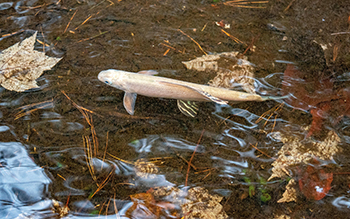
News & Views
Genetics
Restocking
Conservation partnership releases Arctic grayling into Michigan lakes
January 2, 2024 By Hatchery International staff
 Arctic grayling stocking at West John Lake in Alger County on Nov. 8, 2023. (Photo: Michigan DNR)
Arctic grayling stocking at West John Lake in Alger County on Nov. 8, 2023. (Photo: Michigan DNR) The Michigan Arctic Grayling Initiative is well underway with record numbers being stocked in the state’s lakes.
The Michigan Department of Natural Resources (DNR) recently reported that three Michigan lakes were stocked with Arctic grayling in November 2023. These restockings were made possible from a surplus from the establishment of this grayling broodstock initiative.
The Little River Band of Ottawa Indians and the Michigan DNR began a partnership aimed at reintroducing this iconic species to Michigan waters in 2015.
“When starting a year-class of broodstock, you always start with more than you will need in the end to allow for potential losses to disease, mechanical issues, et cetera,” said Ed Eisch, assistant chief of the DNR’s Fisheries division. “Such losses never materialized with the two year-classes that were stocked. The numbers needed to be thinned down to levels that are safe to carry into the future at the Marquette hatchery.”
Four hundred graylings were stocked at Alger County’s West Johns Lake, 300 at Penegor Lake in Houghton County and nearly 1,300 in Manistee County’s Pine Lake.
The fish were taken from the Marquette State Fish Hatchery in Marquette and represented year classes from 2019 and 2021.
With the third year-class recently clearing their requisite health inspections, it is possible that there will be additional surplus available for stocking again next fall.
Anglers are encouraged to use single, barbless hooks and to allow the fish to remain in the water when taking them off the hook to reduce the chances of fish death.
Now that the three lots of future broodstock have been developed, the Little River Band, the DNR and other partner groups are eyeing spring of 2025 as the likely timeline for the first eggs to go into remote site incubators.
Females of one year class need to be spawned with males from a different year class, resulting in the most genetically fit fish possible by avoiding the potential of crossing siblings.
They continue to collect stream data to determine which watershed will be selected to receive the first eggs in this initiative.
Print this page





